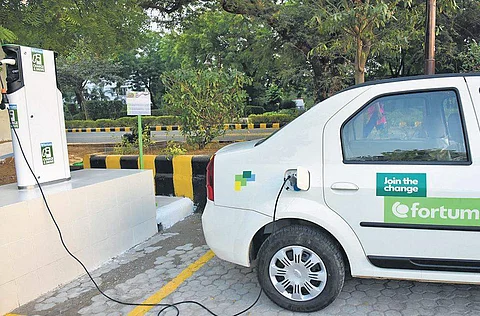

MUMBAI: Despite the aggressive policy push and drive by automakers, electric vehicle's penetration will remain under 5 per cent over the next five years in the 3-million units annual auto market, as per a report.
Rating agency Icra has blamed this to the higher vehicle cost due to costly imported batteries, weak public charging infrastructure and inadequate government support.
It can be noted that globally, EV penetration has been enabled by regulatory support and wider availability of charging stations, with the US and China being the best examples, where there is the mandatory zero-emission rules, and restricted licensing for new petrol/diesel vehicles, respectively.
The government recently sanctioned 2,636 charging stations, under the Fame 2.0 to incentivise investments in the space, which if fructified, will boost EV acceptance over the long-term, the report said.
"EV penetration is expected to remain low at 3-5 per cent till 2025 due to higher prices and inadequate public charging infrastructure.
Being a price sensitive market and the resultant low volume, economies of scale is crucial for an OEM to price its EVs competitively," Icra said on Wednesday.
Since average car realisation being very low compared to markets like the US and China, achieving price parity for EVs with traditional models is likely to take a longer time.
In the longer-term, however, once price parity is achieved, EVs may see exponential growth, it said.
Government support remains crucial to support EV growth.
Assuming subsidy of Rs 1,50,000/vehicle, even just 1 per cent of total domestic passenger vehicle sales in FY20 will need about Rs 450 crore in subsidy support and about Rs 1,300 crore over next three years.
As against this the Fame 2.0 scheme, however, provides limited visibility, as overall subsidy amount is much lower at Rs 525 crore over the next three years.
At present, EV subsidy priority is towards commercial fleet/taxi operators and less on personal car buyers.
Also, high upfront cost of an EV and the higher ownership cost is expected to favour traditional fuel-fired vehicles in the medium term, even in the commercial taxi segment, says the report.
The lack of clarity regarding the long-term roadmap for charging infra as well as the incentive structure for EVs and lithium-ion battery manufacturing facilities in the country.
High import dependence on li-ion batteries and other electronic components significantly dilutes benefits of lower crude import bill due to shift towards EVs, notes the report.
Engine and transmission components account for 30-35 per cent of material cost in a conventional vehicle compared to an EV where battery and associated components (motors, drives) cost 40-45 per cent of total material cost.
But tech progress and higher volumes can lower battery prices, leading to price parity over the next decade, which can alter the EV landscape.
Despite all these, almost every OEM intends to roll out EVs, with some having already launched few of them, like Tata Motors which leads the space now.
The EV vendor ecosystem requires substantial investments to keep cost under check and reduce dependence on imported electronic systems.
Even though during the past decade, EV registration has grown 15 times primarily driven by China, the US and the European markets, the EV share in overall new vehicle sales is still modest.